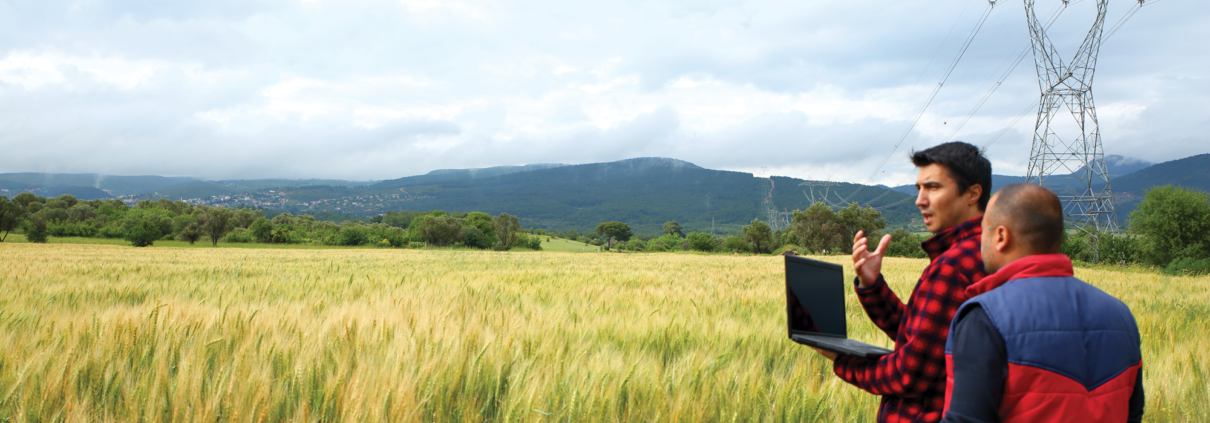Blockchain in land real estate has not quite yet been accepted by business leaders. Misconceptions and misinformation have created an environment that is delaying adoption. While no technology is a universal perfect fit, we should look for situations that benefit from blockchain’s best features. We should take the time to understand blockchains in order to maximize their potential as an asset that can have positive impacts on business.
Understanding Blockchain
Think of blockchain technology as a ledger that is distributed to many parties. Just like a published book, the information recorded in the ledger is permanent, cannot be altered, and everyone who needs a copy of the ledger has one. If you want to change the information that has been published, you have to ensure changes are made to every copy of the book. In terms of a blockchain, the information is across the internet on various computers. The difficulty only increases as the number of books in circulation increase. Another point to note here is that high circulation publications are difficult to completely erase from history.
Just like any new technology, there is a vocabulary associated with blockchains. Breaking down the word blockchain, block being a log of stored data and chain referring to how the data links together, is a good place to start. Then you start hearing words like cryptocurrency, token, coins, and smart contracts, all of this can be overwhelming. For now though, the most important technical term to remember is the overall synonym for blockchain: distributed ledger. As a business leader, keep reminding yourself that blockchains are tamper-proof records with many copies.

Each party operates a copy of the blockchain. The blockchain is simply a reserved part of your computer disk. There are two competing ways information is distributed.
Method 1 – This one is called Byzantine Fault. When you record a new transaction, it is first sent out to all computers to make sure they have a copy that can receive the change. If a majority of the computers agree, your local copy is then changed and all others are alerted to the change.
Method 2 – This one is called Mining. When you record a new transaction, thousands of “miners” are notified. Each one tries to come up with mathematically unique representation of the transaction. The first person to come up with the solution earns part of the fee (every transaction requires a token). This is a tremendously wasteful exercise (from an electricity standpoint) and has been heavily criticized. It has resulted in mining farms operated by folks looking to create revenue.
I have been asked, “If blockchains are a record-keeping mechanism, what is wrong with using databases the way we do today?” My answer is that there is nothing wrong with what we do today. The industry has an enormous investment in documents so any suggestion that we should move millions of them into a blockchain is unrealistic. The effort would be a needless waste of time and storage capacity. However, using the book example, a better approach would be to record the location of a book and then to document any changes that have been made since its publication as new events are added.
The difference between a database and a blockchain is like the difference between a driver’s license and a driving record. Information on your driver’s license is subject to change over time. Your weight, address, and appearance (photo) are best stored in a database because they change over time. Now consider your driving record. It is a series of events that are not subject to change. In a database, the information stored there is subject to change. With a blockchain, the information is a permanent track record of events.
Blockchain in Real Estate
Short, time-based events are easy to record with a blockchain. Asset management activities generate excellent examples of events in commercial and residential real estate. Some of the activities that create events are:
- inventory
- maintenance activities
- tax payments
- improvements
Using blockchains, builders and developers can quickly identify who supplied materials, where they were used, and how they were handled. This is why many supply chain companies (especially food handlers) are adopting blockchains. Blockchains are good at asset management because they create trustworthy records. They create tamper- proof records and no special software, services, or procedures are needed to recover from catastrophic outages. Damaged computers simply reconnect to the network and recreate the lost information from other copies.
The Real Estate Standards Organization (RESO) has created a workgroup that thinks events are applicable beyond real estate brokerage. Events allow real estate professionals to easily exchange information between lending, public records, and insurance companies. The workgroup is not facilitating the exchange of underlying documents, simply a ledger of events (think of a timeline).
Caution Ahead
We should consider the impact of legislative and regulatory efforts to protect privacy on blockchains since they contain tamper-proof, permanent records. If information written to a blockchain can never be erased, personal information like account numbers, passwords, or contact information should not be recorded. The security community calls this kind of information Personally Identifying Information (PII) which has “the right to be forgotten,” according to GDPR. We can expect to see continued legislative and regulatory efforts to protect privacy, so it is important to keep this in mind when implementing blockchain technology in the industry.
Legislative and regulatory actions intended to help consumers can actually end up hurting adoption. A review of actions at the state level published last year showed that blockchain definitions used in legislative language varied significantly between states. We should think about one of the main points in The High Cost of Good Intentions by John F. Cogan; government strives to act in the best interest of the citizens but ends up stopping innovation that is designed to help them. We should be working with local, state, and federal governments to make sure they understand the impacts of their actions.

Still Learning
Earlier this year, I attended the 2019 National Land Conference hosted by the REALTORS® Land Institute (RLI) in Albuquerque, NM, to discuss blockchain technology. One of the challenges I noted was implementing blockchain technology at the county level. The decision-making process at over 3,000 counties slows down adoption significantly since millions of records would have to be transposed.
I was pleasantly surprised to find blockchain uses I had not yet considered. Possible uses for blockchains in land real estate include:
When they were first mentioned, I assumed the issues were similar to those faced in the County Recorder’s office. I came to realize the value of RLI.
We have established that blockchains are good at capturing small events. When a property changes owners, what is purchased can be the result of subdividing or combining tracts. Many county recording systems have difficulty combining properties. Blockchains are good at tracking splits and combinations because they are optimized to record event history.
Recording water rights are more complex because both surface water and groundwater need to be considered. However, as the population increases, simple first-in-time and first-in-right historical surface water rights are being challenged by legislation and regulation. These complexities make recording surface water rights with blockchains an ideal solution.
Groundwater record keeping can be more complex than a simple rule of capture situation. Drilling, natural erosion, and abuse of the aquifer are all conditions that can be detected with periodic testing.
Blockchains can be used to reference test results creating a tamper-proof, time- based record. Indigenous land rights are another area of land transfer that can impact development plans. Blockchain technology is ideally suited to create records that survive multiple transfers and do not need to be routinely researched.
I saved mineral rights for last because they are more complex than the aforementioned items. With water, there are two facets to consider: surface and groundwater. The courts still see disputes over the definition of what constitutes a mineral. Royalty agreements routinely include many parties and need to be researched before the transaction is closed. These complexities can be captured using blockchains.
The effort to record mineral rights with blockchains should avoid capturing old records. Instead, new research should be recorded from this point forward. Many of the records are very old and are needed for historical backup. Scanning and digitizing historical documents do not help the process of documenting mineral rights. Recording mineral rights agreements and interpretations in blockchains create tamper-proof records that many parties can reference electronically.

Cryptocurrency and Smart Contracts
Due to the well documented volatility of cryptocurrency, it is unlikely that we will see wide scale purchasing of property using cryptocurrency. The banks are not ready to lend this form of currency yet and commissions will probably not be paid this way. The number of cryptocurrency property transactions will never exceed today’s volume of 100% cash transactions.
This is a good time to clarify some blockchain jargon. Cryptocurrency denominations are typically called tokens or coins. Tokens must be purchased before use and are not typically interchangeable between applications. Buying and selling tokens is still a complex process, but the community is trying to simplify it. There have also been improvements to token interoperability between blockchains.
Compensating work is a much better application of cryptocurrency. Instead of closing the entire transaction, you can order just those services you would like to be performed electronically. Services can have conditions such as “do not execute during business hours,” or more complex rules, such as, “on the fourth day, transfer $1,000 to this system.” The logic that controls these kinds of services is called a smart contract. Smart contracts are not the same as legal contracts. A traditional legal contract is the outcome of negotiations and often contains attachments, addenda, and amendments related to the transaction. Smart contracts are not unique to a specific transaction. They can operate on a transaction but are not unique to the transaction. Smart contracts only represent conditional logic.
A good example of a smart contract can be found in fund disbursement. The hard part of designing smart contracts is capturing all of the options within a request. Imagine a vending machine that you can use to order transaction services. If the right number and type of tokens are inserted, you can select an in-stock item. The machine releases the item (i.e., the smart contract is executed). If those conditions are not met, the item (if there is one) is not released. The options you want can affect the number of tokens required to select the item.
Final Thoughts and Application
Do not ignore blockchains. Pretending they will not emerge will not stop them. You do not have to understand them at a technical level. Look for blockchains to emerge within business practices that need improvement, especially in the record-keeping area.
The biggest factor that can stop the widespread adoption of blockchains is resistance to change. Business leaders have a fiduciary duty to manage the risk, which includes being wary of unintended consequences. Until the risks are known and at least partially mitigated, policies do not change. Business leaders still need more education about blockchains before they’ll be comfortable with adoption.
Thinking about how blockchain could benefit your real estate business? Practice looking for applications that need both permanent records and require access by many parties. Blockchains will probably enter the industry through applications in ways that most will not even know they are using them. For now, just stay aware and keep an eye out for potential uses in your business.
This article was originally published in the Summer 2019 Terra Firma magazine.
 About the author: Mark Lesswing is a Blockchain Entrepreneur who holds a Bachelor of Science degree in Industrial Engineering from Lehigh University. He started programming robots just out of college and, in 1988, began working with object-oriented programming. Mark has worked for large database vendors such as Sybase (as a startup) and Oracle spending a summer in Europe setting up international operations. In 1992, he launched his own consultancy and was involved in corporate turnarounds. Mark joined the National Association of REALTORS® in 2001 and as the Chief Technology Officer was a tenacious advocate for data standards and innovation. He is a frequent speaker at major trade conferences and is listed in the International Who‘s Who of Information Technology and the National Register of Who’s Who in Executives and Professionals.
About the author: Mark Lesswing is a Blockchain Entrepreneur who holds a Bachelor of Science degree in Industrial Engineering from Lehigh University. He started programming robots just out of college and, in 1988, began working with object-oriented programming. Mark has worked for large database vendors such as Sybase (as a startup) and Oracle spending a summer in Europe setting up international operations. In 1992, he launched his own consultancy and was involved in corporate turnarounds. Mark joined the National Association of REALTORS® in 2001 and as the Chief Technology Officer was a tenacious advocate for data standards and innovation. He is a frequent speaker at major trade conferences and is listed in the International Who‘s Who of Information Technology and the National Register of Who’s Who in Executives and Professionals.
 Chris Miller, ALC, is a land broker and consulting forester for American Forest Management, Inc. in Charlotte, North Carolina.
Chris Miller, ALC, is a land broker and consulting forester for American Forest Management, Inc. in Charlotte, North Carolina.








 About the Author:
About the Author: 





















